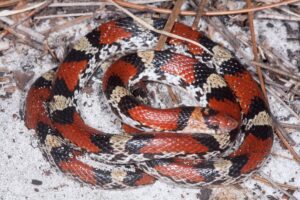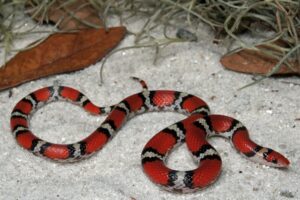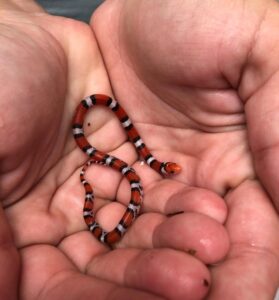The scarlet snake is a small to medium-sized, relatively slender colubrid native to the southeastern United States. The fossorial, secretive species spends a major part of its life underground. A pointed red snout helps it to burrow. It has a striking color pattern or black, red, and white or yellow.
Scientific Classifications
- Suborder:Serpentes
- Family:Colubridae
- Genus:Cemophora
- Species:C. coccinea
Conservation Status
Subspecies
This snake has two recognized subspecies.
- Florida scarlet snake (Cemophora coccinea coccinea)
- Northern scarlet snake (Cemophora coccinea copei)
Description
Size
The adult scarlet snake reaches a total length of 14-26 in (36-66 cm).
Color and Appearance
The dorsal side of the body is of light gray color with a series of black-bordered white, red, or yellow blotches. The pattern can extend down the sides of the body, making it appear like rings or banding. The belly is uniformly white or light gray. The males have longer tails, and the young look similar to the adults.
Are They Dangerous to Humans
The non-venomous snake rarely bites when captured. But it can release a foul-smelling musk in defense.
Scarlet Snakes at a Glance
Distribution
The scarlet snake is only found in the US in eastern Oklahoma, Arkansas, southeastern Texas, parts of Louisiana, Alabama, Mississippi, Georgia, North Carolina, South Carolina, Florida, Tennessee, Illinois, Kentucky, Indiana, Virginia, Delaware, and Maryland. Central Missouri and New Jersey have disjunct populations. It is commonly found all over the Atlantic coastal plain areas.
Habitat
They prefer living in open forested areas with ground litter, sandy soil, and organic debris.
The nocturnal species is active only during the summer months. During the day, they can be found below logs, under pine debris, and other organic litter. At night they can be spotted crossing roads in search of food.
Habitat loss, along with road mortality, illegal capture for pet trade, and direct killing, has decreased its population.
Lifespan
The scarlet snake lives can live for a maximum of 10.4 years.
Predators
Its predators are snakes that eat other snakes, like coral snakes, mammals, and predatory birds.
Diet
The colubrid eats small rodents, lizards, other snakes, and the eggs of turtles, snakes, and lizards. It slashes open large reptile eggs using its very sharp, posterior teeth. Then it squeezes it to extract its contents or thrusts its head inside the egg to break it open.
Reproduction
Oviparous (lays eggs that hatch outside the body)
Breeding occurs throughout spring, and eggs are laid all through summer under rocks and in burrows. A clutch generally contains 2-9 eggs. They hatch after almost two months of breeding, typically in late summer or autumn.
Similar Species
Milk snake
The milk snake, Lampropeltis triangulum, has a black and white checkerboard pattern or the dorsal banded pattern on its belly, whereas the scarletsnake has a plain belly.
Source
floridamuseum.ufl.edu, herpsofnc.org, thumbs.dreamstime.com, reddit.com









